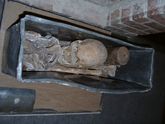Svein Estridsson
- King of Denmark AD 1047-74.
Svein (AD 1020-1074) was the son of Cnut the Great's sister Estrid and her Norwegian husband, Ulf Jarl (Earl Ulf). When the Norwegian king Magnus ascended the Danish throne in AD 1042, Svein was made an earl – just as his father had been under Cnut the Great. In AD 1043, Svein took part in the Battle at Lyrskov Hede, where a great Wendic invasion army was driven back. Svein won a great reputation in the battle and the Danish army elected him as king at Viborg Thing.
This event brought Svein into conflict with Magnus and there were several battles for the Danish throne. In AD 1047 there was a great battle on Zealand where Svein was defeated and was forced to flee. Magnus set off in pursuit but during the chase he was thrown from his horse and died subsequently of his injuries. On his deathbed, he gave over the Norwegian throne to his uncle Harald Hardrada and the Danish throne to Svein.
As Danish king, Svein was on several occasions challenged by Harald Hardrada but they became reconciled in AD 1062 and recognised each other as kings of Denmark and Norway, respectively.
When the English King Edward the Confessor died in AD 1066, Svein saw himself as a possible successor to the English throne, which was, however, overtaken by Harold Godwinson, who quickly lost it to William the Conqueror, duke of Normandy, in the Battle of Hastings. When Harold Godwinson's children subsequently travelled to Roskilde to look for help from Svein, who was their farther's cousin, he chose in AD 1069 to support his brother Asbjörn's expedition to Northern England.
Asbjörn went with two of Svein's sons to the Dane-friendly town of York in order to find support in raising an army against William. In order to frighten the inhabitants into not supporting Asbjörn in a revolt, William had in the meantime burnt fields and houses in the area. The Danes were forced to abandon the expedition and their opportunity to conquer the English throne. Svein Estridsson died in AD 1074 and was buried in Roskilde Cathedral.
Louise Kæmpe Henriksen
